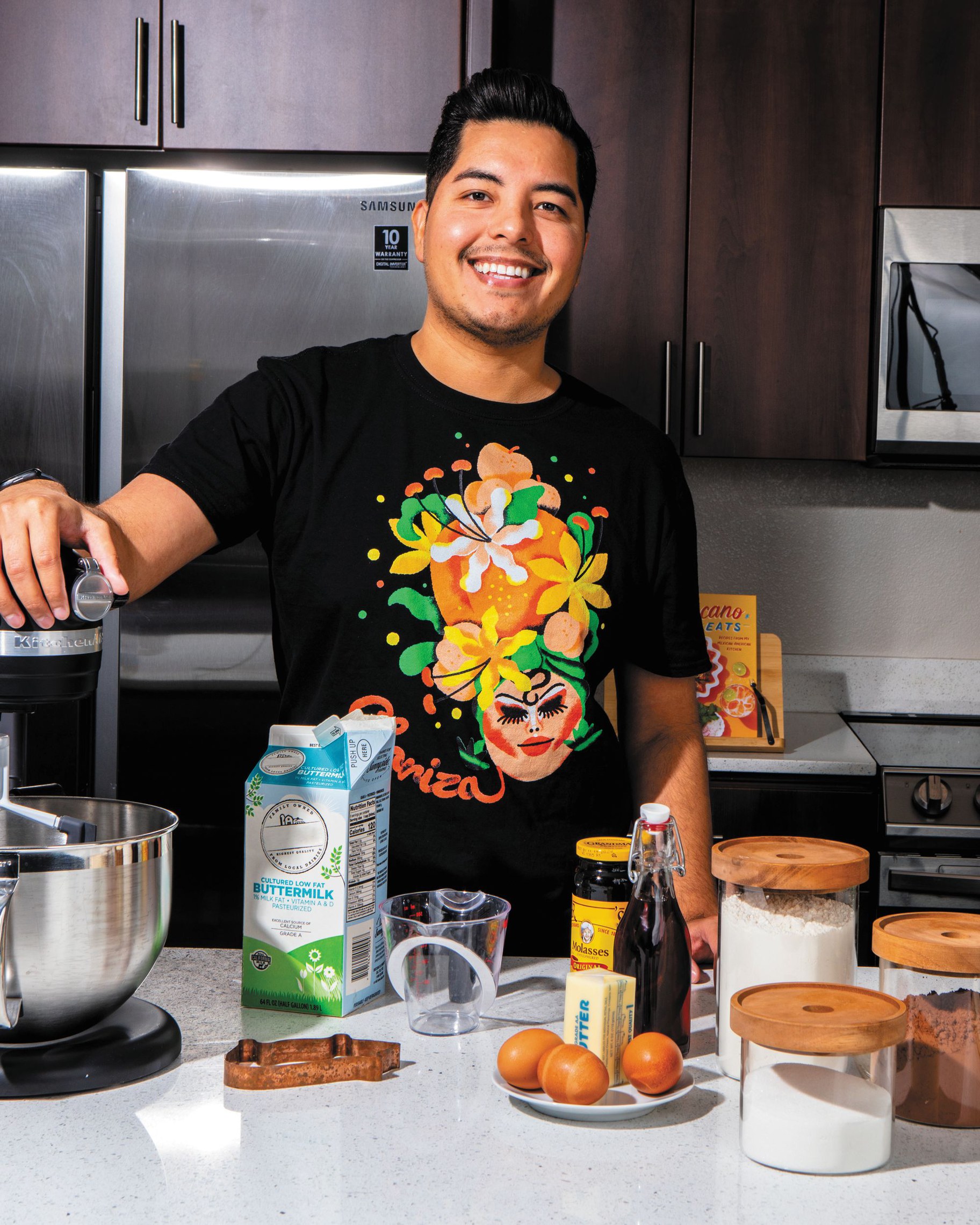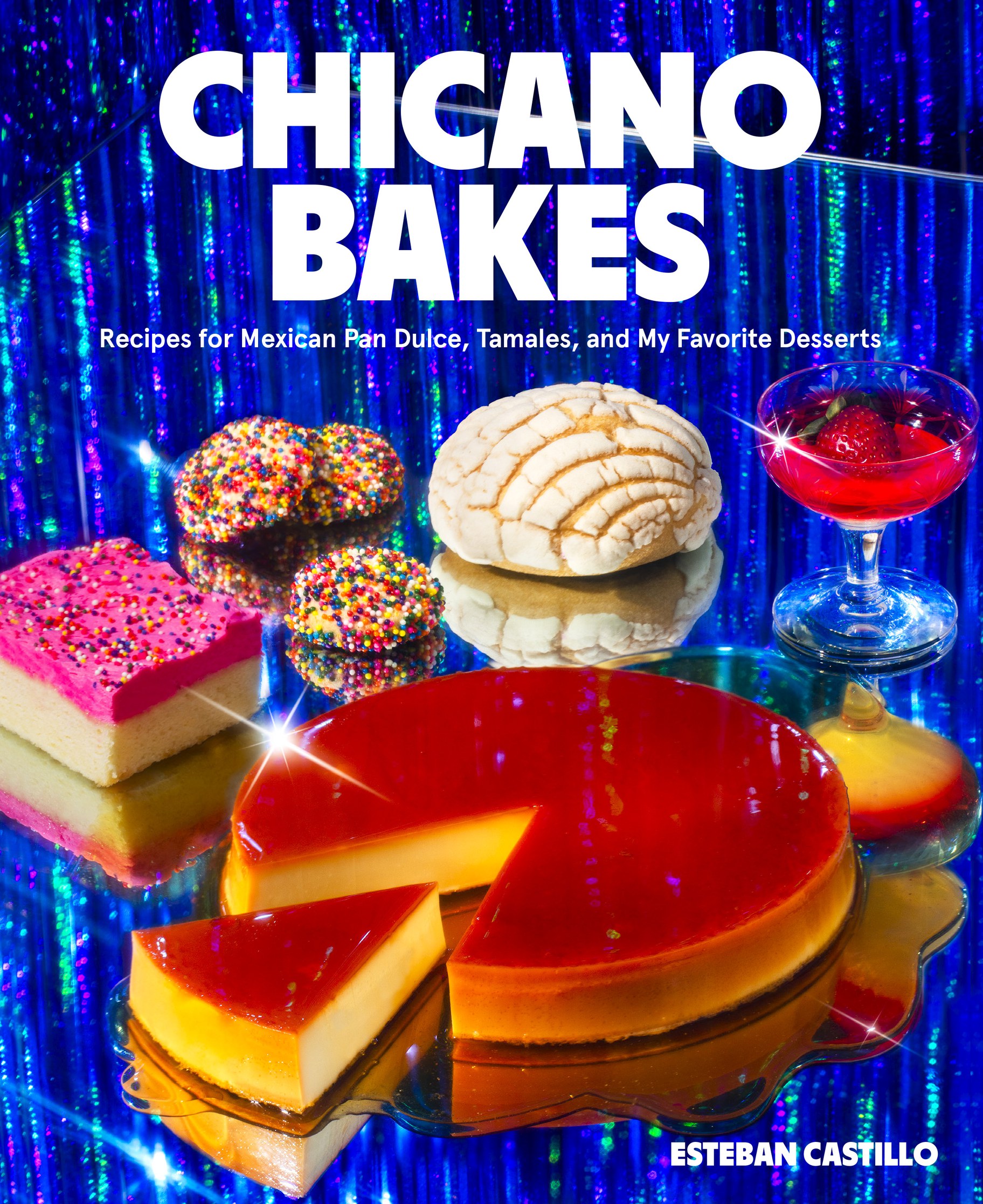Esteban Castillo is a blogger and cookbook author behind Chicano Eats. His latest title is “Chicano Bakes: Recipes for Mexican Pan Dulce, Tamales, and My Favorite Desserts.”
This interview had been edited for length and clarity.
Evan Kleiman: Your recipes focus on that pivotal point in our lives when we move out on our own and begin to miss the food from home. Where did you grow up? And what access did you have to ingredients?
Esteban Castillo: I grew up in Southern California – in Orange County, in Santa Ana. When I moved away for college, it was my first time literally being away from my community and away from my home. I went to school up north in Humboldt County. So when I got there, it was a huge culture shock. I no longer had access to everything that I had within reach – I literally grew up behind a Mexican supermarket. Whenever I wanted fresh queso fresco, I could literally walk across the street, and I had access to everything. Moving away from home and being stranded in the middle of nowhere forced me to get into the kitchen and start working with my hands. My mom's side of the family has always really been involved with food, and it's how they've been able to earn a living. So through all of my trips going back to Mexico, because both of my parents were undocumented, I spent a lot of my time there with my grandparents and I just absorbed a lot.
I wanted to touch on the recipe that went viral from your first cookbook “Chicano Eats” – the chocoflan. It has this extremely enticing drizzle of dulce de leche, and there's a bit of magic surrounding the baking process. Tell us about it.
So when you're making a chocoflan, and
For those of you who are new to the chocoflan, it's a dessert that's comprised of two different layers. On the bottom, you have a really fudgy chocolate cake. On the top, you have a caramel flan. So when you're building the chocoflan, you have your bundt pan, and you typically add in the chocolate cake batter first, and then on top of that, you ladle in the flan mixture. So you bake that in a water bath for about an hour and a half. And so because of their density, they are going to switch – the flan is going to be a lot more dense and it's going to sink to the bottom, and the cake is going to float to the top. When you are done and you invert the cake, everything flips and it's always like producing a really tasty magic trick. Everybody is always wowed. And I've taught classes on the chocoflan before, and every single time people will look at me confused because they'll be like, “Well, didn't you add in the chocolate cake first.” It’s just always really pretty, and it takes minimal effort. It looks really complicated. But honestly everything happens in two, or three bowls. And it's just a really good magic trick to have up your sleeve.
For most of us who didn't grow up in a Mexican community, when we think about pan dulces, we think of conchas – those sweet, colorful breads with a shell-like appearance. Are they very difficult to make? How do you get the designs that you incorporate on the top?
Conchas have become the symbol of pan dulces. When we're talking about pan dulces, we're really just using the term pan dulce as an umbrella to encapsulate all of the different pastries that you'll find at the pan dulce. The concha has really become the symbol here in the U.S.
If you have a little bit of experience, I find that they're not very difficult to make. I feel like they take a lot more time because there's just so much time in between each rest, that it feels like it's difficult. But I like to say that if you are able to follow a really simple set of instructions, then you should have no problem making conchas at home.
The intricate design really just comes from the different bread molds. I like to take the sugar streusel and incorporate different gel food colorings, so that I have these tie-dye toppings, which again, makes them a lot more elevated, and it makes them look like they took a lot more time. Honestly, they're super simple. It's really just having to wait three hours for them to rise because it’s a yeasted dough. It's really approachable, and I really made sure that all of the recipes are able to be followed by anybody at any skill level.
I have made countless amounts of tiramisu. But your tiramisu has a twist that I think is kind of genius. Tell us about it.
As Chicano Eats, one of the things that I like to do is incorporate traditional Mexican flavors and ingredients in non-traditional ways, or pair them with non-traditional ingredients or other flavors. One of the things that I did for this book was I developed a recipe for an horchata tiramisu. And let me tell you, I've been making this tiramisu for like the past six years, and it is always a hit for Thanksgiving. It features this really fluffy cake instead of ladyfingers. You soak the cake in a horchata and espresso mixture, and it just absorbs all of that really cinnamony goodness. Then, you make a fluffy horchata mascarpone cream. Horchata is already perfect on its own, but combining it with marscapone is so much better.
Where do you get your horchata, or how do you make it?
For this recipe, I tell readers that if you already have a favorite local horchata, then I suggest you use that. Because otherwise it's going to add a couple of extra hours to the recipe. But if you would like to make it from scratch, then I have a really good solid recipe and my first cookbook.
In this book I really love your use of masa harina for a bunch of different dishes that range from things we would expect, like tamales or sopes, but also the drinks. As the weather gets a little cooler, and we're looking for something warming and delicious, what are a couple of drinks that you have that add the masa harina to thicken and give it that typical flavor?
Once it starts to get a little bit colder, I like to make champurrado and atole, whether it be a coconut or a vanilla atole. For me growing up in Southern California, this is something that I had every weekend because I used to go to Sunday school. After school there would be these ladies that would sell either tamales, or champurrado and atole outside of the church. So this is something that I grew up having, but it's something that I like to make once it starts to get a little bit colder.
Champurrado is going to be a hot chocolate – you're going to make it with Mexican hot chocolate, and you are going to thicken it with a little bit of masa harina. So it's a little bit more thick, it's a little bit more rich, and the taste of the corn paired with a Mexican chocolate just does so well together. It is a drink that we have in so many different flavors.
Growing up, we also had Maizena, which is not made with corn and masa harina, but it's made with cornstarch. It’s these little packets that we would get at the store and they would come in so many different flavors like walnut, vanilla, or strawberry. I also have a couple of different recipes for those from scratch in the book.
Classic Chocoflan
Serves 16
Chocoflan has been referred to as the “impossible” cake because when you make it, you first add the cake batter to the pan and then pour in the flan—and during the baking process they switch places. Chocoflan is basically a magic trick you can eat! When you invert the cake out of the pan you end up with a bottom layer of moist chocolate cake and a classic vanilla flan on top.
Ingredients
- 1/3 cup (100 g) dulce de leche or cajeta
- 1 (14-ounce/397 g) can sweetened condensed milk
- 1 (12-ounce/340g) can evaporated milk
- 4 ounces (115 g) full-fat cream cheese, at room temperature
- 11/2 teaspoons pure vanilla extract Pinch of salt
- 5 large eggs
- 11/3 cups (167 g) unbleached all-purpose flour
- 1 cup (200 g) sugar
- 1/2 cup (45 g) unsweetened cocoa powder
- 1 teaspoon baking soda
- 1/2 teaspoon baking powder 1/2 teaspoon Diamond Crystal
- kosher salt or 1/4 teaspoon fine sea salt
- 1/2 teaspoon ground cinnamon
Instructions
- Preheat the oven to 350°F (180°C).
- Prepare the pan: Liberally coat a 10-cup Bundt pan (see Note on page 144)with cooking spray. Drizzle the dulce de leche into the bottom of the pan.
- Make the flan custard: In a blender, combine the condensed milk, evaporated milk, cream cheese, vanilla, and salt and blend until smooth, 20 to 30 seconds. Add the eggs and blend for another 10 seconds until smooth.
- Make the chocolate cake batter: Sift the flour, sugar, cocoa powder, baking soda, baking powder, salt, and cinnamon directly into the bowl of a stand mixer fitted with the paddle. Mix on the lowest setting until just combined. Add the softened butter and continue mixing on low speed until the mixture resembles wet sand. Stop the mixer and scrape down the sides of the bowl if needed.
- In a spouted measuring cup, combine the coffee, buttermilk, egg, and vanilla and whisk to combine. With the mixer running on low speed, slowly pour the liquid mixture into the flour/butter mixture. Scrape down the sides of the bowl and beat the mixture on high for a full minute.
- Assemble the chocoflan: Pour the cake batter into the prepared Bundt pan, smoothing out the top with an offset spatula or spoon. Carefully ladle in the flan so you disturb the cake batter as little as possible. Transfer the Bundt pan to a roasting pan or baking dish large enough to fit the Bundt pan. Grease a piece of foil and place it greased side down onto the Bundt pan, folding it over the edges to loosely seal it.
- Transfer the roasting pan with the Bundt pan to a pulled-out oven rack. Pour water (from the tap is fine) into the roasting pan or baking dish to come 2 to 3 inches (5 to 7.5 cm) up the sides of the Bundt pan.
- Bake until a skewer inserted into the cake comes out with little to no crumbs sticking to it, 1 hour 30 minutes to 1 hour 45 minutes. Start checking for doneness at the 11/2-hour mark.

Esteban Castillo grew up in Santa Ana, California, behind a Mexican supermarket and across the street from a panaderia. “Moving away from home forced me to get into the kitchen,” he says, and in college he began cooking dishes that reminded him of home and his community. Photo by Billy Green.
Chicano Bakes is the second cookbook from Esteban Castillo, who embraces the sweets of his childhood with recipes for every skill level. Photo courtesy of Harper Design.
